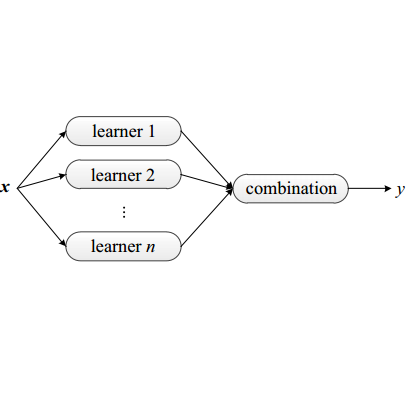Precisely modeling interactions and accurately predicting trajectories of surrounding vehicles are essential to the decision-making and path-planning of intelligent vehicles. This paper proposes a novel framework based on ensemble learning to improve the performance of trajectory predictions in interactive scenarios. The framework is termed Interactive Ensemble Trajectory Predictor (IETP). IETP assembles interaction-aware trajectory predictors as base learners to build an ensemble learner. Firstly, each base learner in IETP observes historical trajectories of vehicles in the scene. Then each base learner handles interactions between vehicles to predict trajectories. Finally, an ensemble learner is built to predict trajectories by applying two ensemble strategies on the predictions from all base learners. Predictions generated by the ensemble learner are final outputs of IETP. In this study, three experiments using different data are conducted based on the NGSIM dataset. Experimental results show that IETP improves the predicting accuracy and decreases the variance of errors compared to base learners. In addition, IETP exceeds baseline models with 50% of the training data, indicating that IETP is data-efficient. Moreover, the implementation of IETP is publicly available at https://github.com/BIT-Jack/IETP.
翻译:精确地模拟周围车辆的相互作用并准确预测其轨迹,对于智能车辆的决策和路径规划至关重要。本文件提议了一个基于共同学习的新框架,以改善互动情景中轨迹预测的性能。这个框架称为交互式连锁轨迹预测(IETP) 。 IETP 将互动-有识轨迹预测器集合为基础学习者,以构建一个共同学习者。首先,IETP 的每个基础学习者观察现场车辆的历史轨迹。然后,每个基础学习者处理车辆之间的相互作用,以预测轨迹。最后,建立一个共同学习者,通过对所有基础学习者的预测应用两种共通战略来预测轨迹。主轨迹预测器产生的预测是IETP的最终产出。在这个研究中,使用不同数据进行的三个实验是在NGSIM数据集的基础上进行的。实验结果显示,IETP 改进了预测准确性和减少与基础学习者之间的差错率。此外,IMTP 现有IETP 数据库显示,IMTP 的50 数据执行率模型已经超过了 IMTP 。



